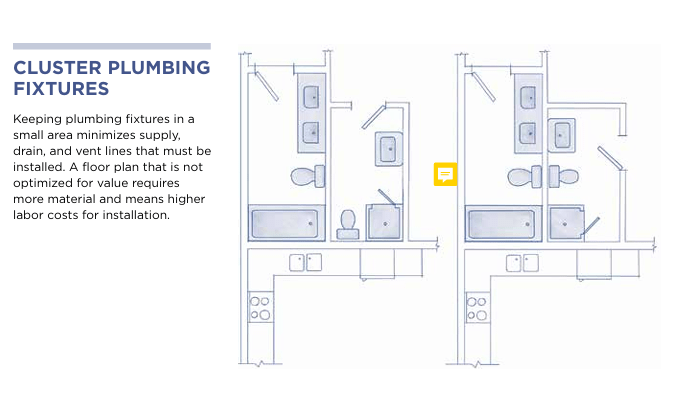A smart plumbing layout is key when building a house, as plumbing is one area where costs can quietly spiral out of control. Labor, long pipe runs, and oversized systems all add up. But with smart plumbing layouts, you can reduce construction costs, save water, and still maintain a high-quality system that appeals to homebuyers.
This guide explores fixture clustering, hot water rectangles, and efficient venting systems that contractors and builders can use to save thousands on plumbing.
Why Smart Plumbing Layout Matters for Your Budget
Plumbing is one of the most labor-intensive parts of home construction. The materials themselves—copper pipes, fittings, valves—are costly, but labor is the biggest expense. Every extra meter of pipe adds time, effort, and risk for leaks later.
Key reasons why layout optimization matters:
Shorter pipe runs = less material and labor.
Fewer fittings and connections = fewer leak points.
Efficient venting and drainage = lower code-compliant material use.
Contractors can save $1,000 to $2,500 per project simply by redesigning plumbing before installation.
1. Cluster and Stack Fixtures to Save Money
The simplest way to cut costs is to keep wet rooms close together.
Cluster fixtures: Place bathrooms, kitchens, and laundry back-to-back or side-by-side to reduce horizontal pipe runs.
Stack fixtures in multi-story homes: Align upstairs bathrooms over downstairs bathrooms to minimize vertical waste and vent lines.
Use 2×6 wet walls: Allows easier routing for both water supply and waste lines without excessive drilling or notching.
Example:
A bathroom, laundry, and kitchen sharing a single wall can cut plumbing runs by 30–50%, which translates to less labor and fewer materials.
2. The Hot Water Rectangle: A Modern Efficiency Concept
Beyond clustering, water heater location plays a huge role in cost and water efficiency.
What Is a Hot Water Rectangle?
Imagine drawing a rectangle around all your wet rooms.
Place the water heater inside or adjacent to this rectangle.
The smaller the rectangle, the faster hot water arrives and the less pipe you need.
Benefits of a Hot Water Rectangle:
Cuts waiting time for hot water.
Reduces water waste, lowering utility bills.
Saves $2,000 or more in labor and pipe costs.
In fact, home design studies show that compact layouts can cut a week of plumbing labor off a project.
3. Prefabricate Plumbing Trees for Repeated Savings
If you’re building multiple similar homes or repeating floor plans:
Ask your plumber to prefabricate vertical plumbing “trees.”
These assemblies combine waste, vent, and water lines into one ready-to-install unit.
Prefabrication reduces on-site labor and minimizes mistakes.
Some supply houses even build these to spec, helping builders save time and money.
4. Reduce Material Use With Smarter Venting
Many older plumbing codes oversize vent and waste systems. Modern homes with low-flow fixtures can safely use smaller-diameter pipes and venting methods, including:
Wet venting: One vent can serve multiple fixtures.
Air Admittance Valves (AAVs): Reduce the need for multiple roof penetrations.
Smart venting design reduces pipe material, fittings, and labor without compromising performance.
Key Takeaways for Builders and Contractors
Plan before building: Optimize wet room placement and water heater location.
Reduce labor first: Labor is the most expensive part of plumbing installation.
Use prefab assemblies: Prefabrication shortens project timelines.
Embrace efficiency layouts: The hot water rectangle and fixture clustering can save thousands.
Plumbing doesn’t have to be a major cost driver in residential construction. By thinking like a designer and a cost-saver, builders can create efficient, compact plumbing layouts that lower labor costs, reduce water waste, and improve homeowner satisfaction.
If you implement fixture clustering, hot water rectangles, and smart venting, you’ll achieve a cost-effective plumbing system that performs just as well as a traditional one—if not better.
Read: Foundation Cost-Saving Strategies – Build Strong Without Overspending





